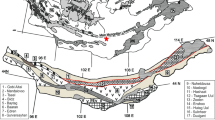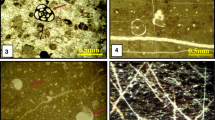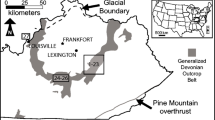Abstract
The Mungok Formation in Yongwol area is divided into four members: i.e., Karam, Paeiljae, Chommal, and Tumok members in ascending order. The basal Karam Member (29–55 m thick) consists mainly of ribbon rock and grainstone to packstone with intercalation of thin limestone conglomerate beds and chert layers. The Paeiljae Member (28.6–35m thick) is a monotonous sequence of light gray to gray, massive to crudely-bedded dolostone. The Chommal Member (30–51 m thick) is characterized by alternation of ribbon rock and limestone conglomerate facies with occasional intercalation of grainstone to packstone beds in the upper part. The uppermost Tumok Member (41.2–77 m thick) comprises ribbon rock, grainstone to packstone, limestone conglomerate, and marlstone to shale.
Trilobites occur in three stratigraphically separated intervals, which are herein referred to theYosimuraspis, Kainella, andShumardia zones, respectively. TheYosimuraspis Zone occurs at the lowermost part of the Karam Member and yieldsYosimuraspis, Jujuyaspis, andElkanaspis, indicating an early Tremadoc age. TheKainella Zone is established based on the occurrence ofKainella andLeiostegium from the basal part of the Chommal Member and is correlated with the middle Tremadoc of North America and Argentina. TheShumardia Zone has a relatively long stratigraphic range covering most of the Tumok Member and is dominated by cosmopolitan trilobite taxa with a few endemic species. This faunal assemblage is well correlated with the late Tremadoc faunas of North China and Australia.
Similar content being viewed by others
References
Acenolaza, F.G. and Acenolaza, G.F., 1992, The genusJujuyaspis as a world reference fossil for the Cambrian—Ordovician boundary. In: Webby, B.D. and Laurie, J.R., (Eds.), Global perspectives on Ordovician Geology. Balkema, Rotterdam, p. 81–92.
Bruton, M.G., Koch, L. and Repetski, J.E., 1988, The Naernes section, Oslo Region, Norway: trilobites, graptolite and conodont fossils reviewed. Geological Magazine 125, 451–455.
Chen, J.Y., Zhou, Z.Y., Zhou, X.P., Lin, Y.K., Yang, X.C., Wang, Q.C., Qi, J.K., Wang, Q.Z. and Lu, X.C., 1980, Ordovician sediments and faunas in the Taihang mountains, North China. Memoirs of Nanjing Institute of Geology and Paleontology, Academica Sinica, 16, 111–148.
Chen, J.-Y., Teichert, C., Zhou, Z.-Y. Lin, Y.-K., Wang, Z.-H. and Xu, J.-T., 1983, Faunal sequences across the Cambrian—Ordovician boundary in northern China and its international correlation. Geologica et Palaeontologica, 17, 1–15.
Chen, J.-Y., Qian, Y.-Y., Lin, Y.-K. Zhang, J.-M., Wang, Z.-H., Yin, L.-M. and Erdtmann, B.D., 1985, Study on Cambrian—Ordovician Boundary Strata and its Biotas in Dayangcha, Hunjiang, Jilin, China. China Prospect Publishing House, 138 p.
Chen, J.-Y., Qian, Y.-Y., Zhang, J.-M., Lin, Y.-K., Yin, L.-M., Wang, Z.-H., Wang, Z.-Z., Yang, J.-D. and Wang, Y.-X., 1988, The recommended Cambrian—Ordovician global boundary stratotype of the Xiaoyangqiao section (Dayangcha, Jilin Province), China. Geological Magazine 125, 415–444.
Choi, D.K., 1998, The Yongwol Group (Cambrian—Ordovician) redefined: a proposal for the stratigraphic nomenclature of the Choson Supergroup. Geoscience Journal, 2, 220–234.
Choi, D.K. and Kim, K.H., 1989, Problematic fossils from the Dumugol Formation (Lower Ordovician), Dongjeom area, Korea. Journal of the Geological Society of Korea, 25, 405–412.
Choi, D.K., Park, K.H. and Kim, D.H., 1994, Tremadocian trilobites from the Mungog Formation, Yeongweol area, Korea. Journal of the Paleontological Society of Korea, 10, 209–226.
Choi, Y.S., Kim, J.C. and Lee, Y.I., 1993, Subtidal flat-pebble conglomerates from the early Ordovician Mungok Formation, Korea: origin and depositional process. Journal of the Geological Society of Korea, 29, 15–29.
Dean, W.T., 1989, Trilobites from the Survey Peak, Outram and Skoki Formations (Upper Cambrian—Lower Ordovician) at the Wilcox Pass, Jasper National Park, Alberta. Geological Survey of Canada Bulletin, 389, 141 p.
Duan, J.Y., An, S.L. and Zhao, D., 1986, Cambrian—Ordovician Boundary and its Interval Biotas, Southern Jilin, Northeast China. Changchun College of Geology, Changchun, 124 p.
Geological Investigation Corps of Taebaegsan Region (GICTR), 1962, Report on the Geology and Mineral Resources of the Taebaegsan Region. Geological Society of Korea, Seoul, 89 p. (in Korean)
Harrington, H.J., 1937, On some Ordovician fossils from northern Argentina. Geological Magazine, 74, 97–124.
Harrington, H.J and Kay, M., 1951, Cambrian and Ordovician faunas of eastern Columbia. Journal of Paleontology, 25, 655–668.
Harrington, H.J. and Leanza, A.F., 1957, Ordovician trilobites of Argentina. Department of Geology, University of Kansas Special Publication, 1, 276 p.
Hintze, L.F., 1953, Lower Ordovician trilobites from western Utah and eastern Nevada. Utah Geological and Mineralogical Survey Bulletin, 48, 1–249. (dated 1952)
Jell, P.A., 1985, Tremadocian trilobites from the Digger Island Formation, Waratah Bay, Victoria. Memoirs of the Museum of Victoria, 46, 53–88.
Kim, D.H., 1999, Stratigraphy and Paleontology of the Lower Ordovician Mungok Formation, Yongwol, Korea. Unpublished Ph.D. thesis, Seoul National University, Seoul, 263 p.
Kim, D.H. and Choi, D.K., 1995,Kainella (Trilobita, Early Ordovician) from the Mungog Formation of Yeongweol area and its stratigraphic significance. Journal of the Geological Society of Korea, 31, 576–582.
Kim, D.H. and Choi, D.K., 1999, Occurrence ofLeiostegium (trilobita, Early Ordovician) from the Mungok Formation. Journal of the Paleontological Society of Korea, 15, 109–114.
Kim, D.H. and Choi, D.K., 2000,Jujuyaspis and associated trilobites from the Mungok Formation (Lower Ordovician), Yongwol, Korea. Journal of Paleontology, 74. (in press)
Kim, B.K., Cheong, C.H. and Choi, D.K., 1990, Occurrences ofSphenothallus (Vermes) from the Mungog and Yobong formations, Yeongweol Area, Korea. Journal of the Geological Society of Korea, 26, 454–460.
Kim, K.H., Choi, D.K. and Lee, C.Z., 1991, Trilobite biostratigraphy of the Dumugol Formation (Lower Ordovician) of Dongjeom area, Korea. Journal of the Paleontological Society of Korea, 7, 106–115.
Kobayashi, T., 1934, The Cambro-Ordovician formations and faunas of South Chosen, Palaeontology. Part 2. Lower Ordovician Faunas. Journal of the Faculty of Science, Imperial University of Tokyo, Section II, 3, 521–585.
Kobayashi, T., 1935, On theKainella fauna of the Basal Ordovician age found in Argentina. Japanese Journal of Geology and Geography, 12, 59–67.
Kobayashi, T., 1953, On the Kainellidae. Japanese Journal of Geology and Geography, 23, 37–61.
Kobayashi, T., 1960, Cambro-Ordovician formations and faunas of South Korea, Part VI, Paleontology V.. Journal of the Faculty of Science, University of Tokyo, Section II, 3, 217–275.
Kobayashi, T., 1966, Stratigraphy of the Chosen Group in Korea and South Manchuria and its relation to the Cambro-Ordovician formations of other areas, Section A, The Chosen Group of South Korea. Journal of the Faculty of Science, University of Tokyo, Section II, 16, 1–84.
Kobayashi, T. and Kimura, T., 1942, A discovery of a few Lower Ordovician graptolites in South Chosen with a brief note on the Ordovician zones in eastern Asia. Japanese Journal of Geology and Geography 18, 307–311.
Kwon, Y.K., 2000, Origin of Limestone Conglomerates in the Choson Supergroup (Cambro-Ordovician), Taebaeksan Basin, Korea. Unpublished MS thesis, Seoul National University, Seoul, 155 p.
Loch, J.D., Stitt, J.H. and Derby, J.R., 1993, Cambrian—Ordovician boundary interval extinctions: implications of revised trilobite and brachiopod data from Mount Wilson, Alberta, Canada. Journal of Paleontology, 67, 497–517.
Lochman, C., 1965, Lower Ordovician (Zone D) faunules from the Williston Basin, Montana. Journal of Paleontology, 39, 466–486.
Lu, Y-H. and Zhou, T-R., 1990, Trilobites across the Cambrian— Ordovician boundary of the transitional region of Sandu, Southeastern Guizhou. Palaeontologia Cathayana, 5, 1–84.
Norford, B.S., Bolton, T.C., Copeland, M.J., Cumming, L.M. and Sinclair, G.W., 1970, Ordovician and Silurian faunas. In: Douglas, R.J.W. (Ed.), Geology and Economic Minerals of Canada. Geological Survey of Canada, Economic Geology Report no.1, p. 601–613.
Paik, I.S., Woo, K.S. and Chung, G.S., 1991, Stratigraphic, sedimentologic and paleontologic investigation of the Paleozoic sedimentary rocks in Yeongweol and Gabsan areas: depositional environments of the Lower Ordovician Mungog formation in the vicinity of Yeongweol. Journal of the Geological Society of Korea, 27, 357–370.
Park, K.H., Choi, D.K. and Kim, J.H., 1994, The Mungog Formation (Lower Ordovician) in the northern part of Yeongweol area: lithostratigraphic subdivision and trilobite faunal assemblages. Journal of the Geological Society of Korea, 30, 168–181.
Peng, S.C., 1984, Cambrian—Ordovician boundary in the Cili-Taoyuan border area, northwestern Hunan, with descriptions of relative trilobites. In: Nanjing Institute of Geology and Palaeontology (Comp.), Stratigraphy and Paleontology of systematic boundaries in China, Cambrian—Ordovician boundary (1), Anhui Science and Technology Publishing House, p. 285–405.
Peng, S.C., 1990a, Tremadocian Stratigraphy and trilobite fauna of Northwestern Hunan. 1. Trilobite from the Nantsinkwan Formation of the Yangtze Platform. Beringeria, 2, 1–53.
Peng, S.C., 1990b, Tremadocian stratigraphy and trilobite fauna of Northwestern Hunan. 2. Trilobites from the Panjiazui Formation and the Madaoyu Formation in the Jiangnan Slope Belt. Beringeria, 2, 55–171.
Pratt, B.R., 1988, An Ibexian (Early Ordovician) trilobite faunule from the type section of the Rabbitkettle Formation (southern Mackenzie Mountains, Northwest Territories). Canadian Journal of Earth Sciences, 25, 1595–1607.
Pribyl, A. and Vanek, J., 1980, Ordovician trilobites of Bolivia. Rozpravy Ceskoslovenske Akademie Ved, Rada Matematickych a Prirodnich Ved 90, 90 p.
Ross, R.J. (ed.), 1982, The Ordovician System in the United States. IUGS, Publication no.12, 73 p.
Shergold, J.H., 1975, Late Cambrian and Early Ordovician trilobites from the Burke River structural belt, western Queensland, Australia. Bureau of Mineral Resources, Geology and Geophysics Bulletin 153 (2 vols.), 251 p.
Shergold, J.H., 1991, The Pacoota Sandstone, Amadeus Basin, Northern Territory: Stratigraphy and Palaeontology. Bureau of Mineral Resources, Geology and Geophysics Bulletin 237, 93 p.
Shergold, J.H., 2000, The Early Ordovician trilobite genus Jujuyaspis in Australia. In: Acenolaza, G.F. and Peralta, S. (eds.), Cambrian from the Southern Edge. Instituto Superior De Correlacion Geologica, Miscelanea, 6, p. 128–130.
Son, C.M., Kim, H.S., Paik, K.H. and Lee, M.H., 1969, Geologic structure of Yemi—Yeongweol area. Journal of the Geological Society of Korea, 5, 123–143 (in Korean)
Stitt, J.H. and Miller, J., 1987,Jujuyaspis borealis and associated trilobites and conodonts from the Lower Ordovician of Texas and Utah. Journal of Paleontology, 61, 112–121.
Webby, B.D., VandenBerg, A.H.M., Cooper, R.A., Banks, M.R., Burrett, C.F., Henderson, R.A., Clarkson, P.D., Hughes, C.P., Laurie, J., Stait, B., Thomson, M.R.A. and Webers, G.F., 1981, The Ordovician System in Australia, New Zealand and Antarctica, correlation chart and explanatory notes. International Union of Geological Sciences, Publication no. 6, 64 p.
Winston, D. and Nicholls, H., 1967, Late Cambrian and Early Ordovician faunas from the Wilberns Formation of Central Texas. Journal of Paleontology, 41, 66–96.
Yosimura, L., 1940, Geology of the Neietsu District, Kogendo, Tyosen (Korea). Journal of the Geological Society of Japan, 47, 112–122 (in Japanese)
Zhou, Z.Y. and Fortey, R.A., 1986, Ordovician trilobites from North and Northeast China. Palaeontographica Abt. A 192, 157–210.
Zhou, Z.-Y. and Zhang, J.-L., 1978, Cambrian—Ordovician boundary of the Tangshan area with descriptions of the related trilobite fauna. Acta Paleontologica Sinica, 17, 1–32.
Zhou, Z.-Y. and Zhang, J.-L., 1985, Uppermost Cambrian and Lowest Ordovician trilobites of North and North-east China. In: Stratigraphy and paleontology of systematic boundaries in China, Cambro-Ordovician boundary (2). Anhui Science and Technology Publishing House, Anhui, China, p. 63–163.
Author information
Authors and Affiliations
Rights and permissions
About this article
Cite this article
Kim, D.H., Choi, D.K. Lithostratigraphy and biostratigraphy of the Mungok Formation (Lower Ordovician), Yongwol, Korea. Geosci J 4, 301–311 (2000). https://doi.org/10.1007/BF02914039
Received:
Accepted:
Issue Date:
DOI: https://doi.org/10.1007/BF02914039




